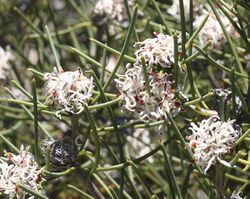Biology:Petrophile semifurcata
| Petrophile semifurcata | |
|---|---|

| |
| Near Tenindewa | |
| Scientific classification | |
| Kingdom: | Plantae |
| Clade: | Tracheophytes |
| Clade: | Angiosperms |
| Clade: | Eudicots |
| Order: | Proteales |
| Family: | Proteaceae |
| Genus: | Petrophile |
| Species: | P. semifurcata
|
| Binomial name | |
| Petrophile semifurcata F.Muell. ex Benth.[1]
| |
Petrophile semifurcata is a species of flowering plant in the family Proteaceae and is endemic to an area near the west coast of Western Australia. It is an erect, bushy shrub with sharply-pointed, needle-shaped, sometimes lobed leaves and oval heads of silky-hairy, whitish, lemon-yellow or cream-coloured flowers.
Description
Petrophile semifurcata is an erect, bushy shrub that typically grows to a height of 0.3–1.7 m (1 ft 0 in–5 ft 7 in) and has softly-hairy branchlets. The leaves are glabrous, needle-shaped, sharply-pointed, 70–145 mm (2.8–5.7 in) long, sometimes with two or three lobes, the lobes sometimes divided again near the tip. The flowers are arranged on the ends of branchlets in oval heads 20–40 mm (0.79–1.57 in) long on a peduncle 8–16 mm (0.31–0.63 in) long, with deciduous bracts at the base. The flowers are about 14 mm (0.55 in) long, whitish, lemon-yellow or cream-coloured and silky-hairy. Flowering occurs from September to November and the fruit is a nut, fused with others in an oval head 25–38 mm (0.98–1.50 in) long on a peduncle 10–20 mm (0.39–0.79 in) long.[2][3][4]
Taxonomy
Petrophile semifurcata was first formally described in 1870 by George Bentham in Flora Australiensis from an unpublished description by Ferdinand von Mueller of material collected by Augustus Frederick Oldfield near the Murchison River.[5][6] The specific epithet (semifurcata) means "half-forked", referring to the sometime simple, sometimes forked leaves.[7]
Distribution and habitat
This petrophile grows in heath on sandy-gravelly soils, sometimes with Banksia species and is found mainly between Geraldton and Kalbarri in the Avon Wheatbelt, Carnarvon, Geraldton Sandplains and Yalgoo biogeographic regions in the west of Western Australia.[2][3][4]
Conservation status
Petrophile semifurcata is classified as "not threatened" by the Government of Western Australia Department of Parks and Wildlife.[3]
References
- ↑ "Petrophile semifurcata". Australian Plant Census. https://biodiversity.org.au/nsl/services/apc-format/display/60729.
- ↑ 2.0 2.1 Foreman, David B.. "Petrophile semifurcata". Australian Biological Resources Study, Department of Agriculture, Water and the Environment: Canberra. https://profiles.ala.org.au/opus/foa/profile/Petrophile%20semifurcata.
- ↑ 3.0 3.1 3.2 "Petrophile semifurcata". FloraBase. Western Australian Government Department of Parks and Wildlife. https://florabase.dpaw.wa.gov.au/browse/profile/2307.
- ↑ 4.0 4.1 Rye, Barbara L.; Hislop, Michael C.; Shepherd, Kelly A.; Hollister, Chris (2011). "New south-western Australian members of the genus Petrophile (Proteaceae: Petrophileae), including a hybrid". Nuytsia 21 (2): 61. https://florabase.dpaw.wa.gov.au/science/nuytsia/570.pdf. Retrieved 4 January 2021.
- ↑ "Petrophile semifurcata". APNI. https://id.biodiversity.org.au/instance/apni/465970.
- ↑ Bentham, George; von Mueller, Ferdinand (1870). Flora Australiensis. 5. London: Lovell Reeve & Co.. pp. 335–336. https://www.biodiversitylibrary.org/page/26124474#page/347/mode/1up. Retrieved 5 January 2021.
- ↑ Sharr, Francis Aubi; George, Alex (2019). Western Australian Plant Names and Their Meanings (3rd ed.). Kardinya, WA: Four Gables Press. p. 304. ISBN 9780958034180.
Wikidata ☰ Q18082645 entry
 |

